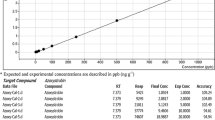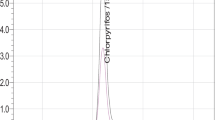Abstract
The increasing use of gibberellic acid (GA3) to promote fruit growth and yield has necessitated research into its trace level determination and estimation in harvested product. The phytohormone has increased the tomato yield (tonne ha−1) up to 24.7% with uniform fruit shape, size colour and lustre. A fast, simple, high-throughput analytical method was standardised based on electrospray ionisation — liquid chromatography-tandem mass spectrometry (LC–MS/MS). The samples were extracted using acidified (1% formic acid) methanol. The method was validated as per the SANTE/12682/2019 guidelines. The limits of detection (LOD) and quantification (LOQ) were 0.01 and 0.05 mg kg−1. The average recoveries at LOQ and higher levels were in the range of 86–108% with relative standard deviation (RSD) < 20%. The validated method was successfully applied under field condition by following first-order kinetics with half-lives (T1/2) 1.76 days (recommended dose) and 1.99 days (double dose). The estimated pre-harvest intervals (PHIs) were 6 days (recommended dose) and 8 days (double dose). Studies on dietary risk assessment concluded that even after spray of GA3 at recommended dose, the harvested produce (tomato) could be consumed safely.


Similar content being viewed by others
Data availability statement
All the datasets of this work are incorporated within the text and the tables.
References
APEDA. (2020). The Agricultural and Processed Food Products Export Development Authority. http://agriexchange.apeda.gov.in/indexp/Product_description.aspx. Accessed 18 Jan 2021
Arteca, R. N. (1996). Plant growth substances: Principles and application. Chapman and Hall Inc. New York. Accessed 18 Jan 2021
Camara, M. C., Vandenberghe, L. P. S., & Rodrigues, C. (2018). Current advances in gibberellic acid (GA3) production, patented technologies and potential applications. Planta, 248, 1049–1062. https://doi.org/10.1007/s00425-018-2959-x
Choudhury, S., Islam, N., Sarkar, M. D., & Ali, M. A. (2013). Growth and yield of summer tomato as influenced by plant growth regulators. Int. J. Sustain. Agric, 5, 25–28. https://doi.org/10.5829/idosi.ijsa.2013.05.01.317
Chen, H., Liu, X., Yang, D., & Yin, P. (2013). Degradation pattern of gibberellic acid during the whole process of tea production. Food Chemistry, 138, 976–981. https://doi.org/10.1016/j.foodchem.2012.10.110
CIBRC. (2019). Central Insecticides Board & Registration Committee. http://www.cibrc.nic.in/muppgr2012.doc. Accessed 18 Jan 2021
EFSA. (2012). European Food Safety Authority. https://www.efsa.europa.eu/en/efsajournal/pub/2507
Golge, O., & Kabak, B. (2015). Evaluation of QuEChERS sample preparation and liquid chromatography-triple-quadrupole mass spectrometry method for the determination of 109 pesticide residues in tomatoes. Food Chemistry, 176, 319–332. https://doi.org/10.1016/j.foodchem.2014.12.083
Gupta, V., Kumar, M., Brahmbhatt, H., Reddy, C. R. K., Seth, A., & Jha, B. (2011). Simultaneous determination of different endogenetic plant growth regulators in common green seaweeds using dispersive liquid-liquid microextraction method. Plant Physiology and Biochemistry, 49, 1259–1263. https://doi.org/10.1016/j.plaphy.2011.08.004
Horticultural-statistics. (2017). Horticultural statistics at a glance. http://nhb.gov.in/statistics/Publication/Horticulture. Accessed 18 Jan 2021
Hou, S., Zhu, J., Ding, M., & Lv, G. (2008). Simultaneous determination of gibberellic acid, indole-3-acetic acid and abscisic acid in wheat extracts by solid-phase extraction and liquid chromatography-electrospray tandem mass spectrometry. Talanta, 76, 798–802. https://doi.org/10.1016/j.talanta.2008.04.041
IndustryARC. (2021). IndustryARC report. https://www.industryarc.com/Report/242/global-plant-growth-regulators-market-analysis-report.html. Accessed 18 Jan 2021
Iqbal, N., Nazar, R., Khan, M. I. R., Masood, A., & Khan, N. A. (2011). Role of gibberellins in regulation of source-sink relations under optimal and limiting environmental conditions. Current Science, 100, 998–1007.
Karmakar, R., & Kulshrestha, G. (2009). Persistence, metabolism and safety evaluation of thiamethoxam in tomato crop. Pest Management Science, 65, 931–937. https://doi.org/10.1002/ps.1776
Mandal, S., Poi, R., Ansary, I., Hazra, D. K., Bhattacharyya, S., & Karmakar, R. (2020). Validation of a modified QuEChERS method to determine multiclass multipesticide residues in apple, banana and guava using GC–MS and LC–MS/MS and its application in real sample analysis. SN Applied Sciences, 2(2), 1-14. https://doi.org/10.1007/s42452-020-1990-2
MarketsandMarkets (2021) MarketsandMarkets report. https://www.marketsandmarkets.com/Market-Reports/plant-growth-regulators-market-94580110.html. Accessed 18 Jan 2021
Nian, Q., Ai, L., Li, D., Chen, X., Zhang, L., Wang, M., & Wang, X. (2018). Rapid monitoring of plant growth regulators in bean sprouts via automated on-line polymeric monolith solid-phase extraction coupled with liquid chromatography tandem mass spectrometry. Analytical and Bioanalytical Chemistry, 410, 7239–7247. https://doi.org/10.1007/s00216-018-1334-x
Oulkar, D. P., Banerjee, K., & Kulkarni, S. (2011). Multiresidue analysis of plant growth regulators in grapes by triple quadrupole and quadrupole-time of flight-based liquid chromatography/mass spectrometry. Journal of AOAC International, 94, 1715–1721. https://doi.org/10.5740/jaoacint.SGEOulkar
Pramanik, K. P., Mohapatra, P. (2017). Role of auxin on growth, yield and quality of tomato—A review. Int J Curr Microbiol Appl Sci, 6,1624–1636. https://doi.org/10.20546/ijcmas.2017.611.195
Saha, S., Mondal, R., Mukherjee, S., Sarkar, M., & Kole, R. K. (2017). Persistence of acetamiprid in paddy and soil under West Bengal agro-climatic conditions. Environmental monitoring and assessment, 189(4), 150. https://doi.org/10.1007/s10661-017-5871-0
SANTE. (2019). European Commission. https://www.eurl-pesticides.eu/userfiles/file/EurlALL/AqcGuidance_SANTE_2019_12682.pdf. Accessed 8 Apr 2021
Saptari, R. T., & Dewi, K. (2013). Effect of borax and gibberellic acid on the growth and development of red chilli (Capsicum annuum L.“gelora”). In The Third Basic Science International Conference.(B41) (pp. 1-3).
Sarkar, M. D., Jahan, M. S., Kabir, M. H., Kabir, K., & Rojoni, R. N. (2014). Flower and fruit setting of summer tomato regulated by plant hormones. Appl. Sci. Rep, 7, 117-120. https://doi.org/10.15192/PSCP.ASR.2014.3.3.117120.
Satti, S. M., & Oebekar, N. P. (1986). Effect of benzyl adenine and gibberellin on flowering and fruit set of tomato over high temperature. Acta Horticulture, 190, 347–354.
Savini, S., Bandini, M., & Sannino, A. (2019). An improved, rapid, and sensitive ultra-high-performance liquid chromatography-high-resolution orbitrap mass spectrometry analysis for the determination of highly polar pesticides and contaminants in processed fruits and vegetables. Journal of Agriculture and Food Chemistry, 67, 2716–2722. https://doi.org/10.1021/acs.jafc.8b06483
Ugare, B., Banerjee, K., Ramteke, S. D., Pradhan, S., Oulkar, D. P., Utture, S. C., & Adsule, P. G. (2013). Dissipation kinetics of forchlorfenuron, 6-benzyl aminopurine, gibberellic acid and ethephon residues in table grapes (Vitis vinifera). Food Chemistry, 141, 4208–4214. https://doi.org/10.1016/j.foodchem.2013.06.111
Wang, K. S., Lu, C. Y., & Chang, S. H. (2011). Evaluation of acute toxicity and teratogenic effects of plant growth regulators by Daphnia magna embryo assay. Journal of Hazardous Materials, 190, 520–528. https://doi.org/10.1016/j.jhazmat.2011.03.068
Wang, R., Yang, J., Shi, Z., & Ou, L. (2008). Separation of gibberellic acid (GA3) by macroporous adsorption resins. Frontiers of Chemical Engineering in China, 2, 171–175. https://doi.org/10.1007/s11705-008-0025-0
Zhang, F., Zhao, P., Shan, W., Gong, Y., Jian, Q., & Pan, C. (2012). Development of a method for the analysis of four plant growth regulators (PGRs) residues in soybean sprouts and mung bean sprouts by liquid chromatography-tandem mass spectrometry. Bulletin of Environment Contamination and Toxicology, 89, 674–679. https://doi.org/10.1007/s00128-012-0739-z
Acknowledgements
The authors are grateful to Indian Council of Agricultural Research (ICAR), New Delhi, India, for the financial support.
Author information
Authors and Affiliations
Corresponding author
Ethics declarations
Conflict of interest
The authors declare no competing interests.
Additional information
Publisher's Note
Springer Nature remains neutral with regard to jurisdictional claims in published maps and institutional affiliations.
Supplementary information
Below is the link to the electronic supplementary material.
Rights and permissions
About this article
Cite this article
Mandal, S., Poi, R., Banerjee, K. et al. Bioefficacy, residue dynamics and dietary risk assessment of gibberellic acid in improving the potential yield of tomato (Solanum lycopersicum L.). Environ Monit Assess 193, 652 (2021). https://doi.org/10.1007/s10661-021-09456-6
Received:
Accepted:
Published:
DOI: https://doi.org/10.1007/s10661-021-09456-6




